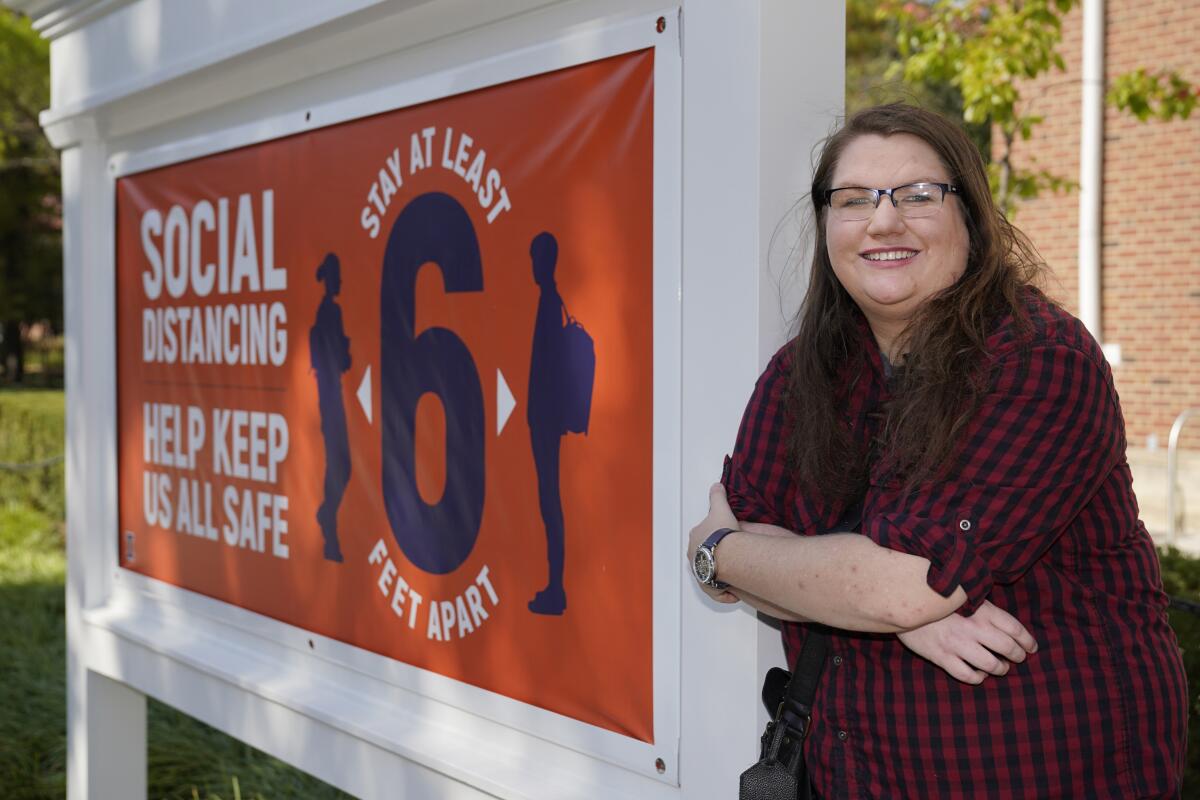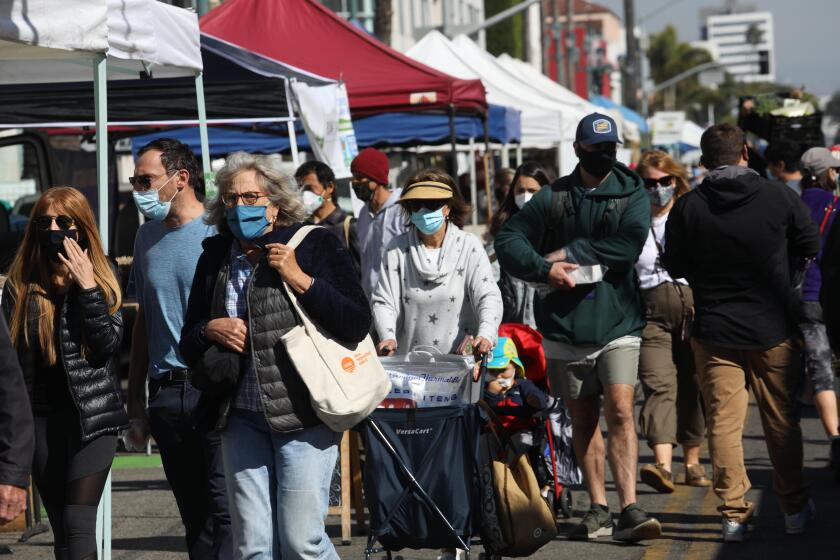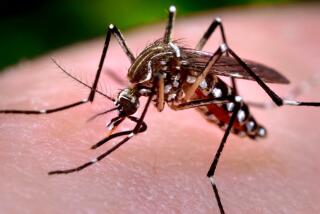Public health programs see surge in students amid pandemic

- Share via
PROVIDENCE, R.I. — As the novel coronavirus emerged in the news in January, Sarah Keeley was working as a medical scribe and considering what to do with her biology degree.
By February, as the disease crept across the U.S., Keeley found her calling: a career in public health. “This is something that’s going to be necessary,” Keeley remembered thinking. “This is something I can do. This is something I’m interested in.”
In August, Keeley began studying at the University of Illinois at Urbana-Champaign to become an epidemiologist.
Public health programs in the United States have seen a surge in enrollment as the coronavirus has swept through the country, killing more than 248,000 people. As state and local public health departments struggle with unprecedented challenges — slashed budgets, surging demand, staff departures and even threats to workers’ safety — a new generation is entering the field.
Among the more than 100 schools and public health programs that use the common application (a single admissions application form that students can send to multiple schools), there was a 20% increase — to nearly 40,000 — in applications for the current academic year to programs for earning a master’s degree in public health, according to the Association of Schools and Programs of Public Health.
Some programs are seeing even bigger jumps. Applications to Brown University’s small master’s in public health program rose 75%, according to Annie Gjelsvik, a professor and director of the program.
Demand was so high as the pandemic hit full force in the spring that Brown extended its application deadline by over a month. Seventy students ultimately matriculated this fall, up from 41 last year.
“People interested in public health are interested in solving complex problems,” Gjelsvik said. “The COVID pandemic is a complex issue that’s in the forefront every day.”
A coronavirus outbreak tied to a wedding reception caused 177 infections and 7 COVID-19 deaths. It shows why health officials are nervous about holiday gatherings.
It’s too early to say whether the jump in interest in public health programs is specific to that field or reflects a broader surge of interest in graduate programs in general, according to those who track graduate school admissions. Factors such as pandemic-related deferrals and disruptions in international student admissions make it difficult to compare programs across the board.
Magnolia E. Hernández, an assistant dean at Florida International University’s Robert Stempel College of Public Health and Social Work, said new student enrollments in its master’s in public health program grew 63% from last year. The school has especially seen an uptick in interest among Black students, from 21% of newly admitted students last fall to 26.8% this year.
Kelsie Campbell is one of them. She’s part Jamaican and part British. When she heard in both the British and American media that Black and ethnic minorities were being disproportionately hurt by the pandemic, she wanted to focus on why.
“Why is the Black community being impacted disproportionately by the pandemic? Why is that happening?” Campbell asked. “I want to be able to come to you and say, ‘This is happening. These are the numbers and this is what we’re going to do.’”
The biochemistry major at Florida International said she planned to explore that when she began her master’s program at Stempel College in the spring. She said she hoped to eventually put her public health degree to work helping her own community.
“There’s power in having people from your community in high places,” she said, “somebody to fight for you, somebody to be your voice.”
Public health students are already working on the front lines of the nation’s pandemic response in many locations. Students at Brown’s public health program, for example, are crunching infection data and tracing the spread of the disease for the Rhode Island Department of Health.
Officials are sounding the alarm about the rapid spread of the coronavirus and have warned that more restrictions could come, even a possible curfew.
Some students who had planned to work in public health shifted their focus as they watched the devastation of COVID-19 in their communities. In college, Emilie Saksvig, 23, double-majored in civil engineering and public health. She was supposed to start working this year as a Peace Corps volunteer to help with water infrastructure in Kenya. She had dreamed of working overseas on global public health.
The pandemic forced her to cancel those plans, and she decided instead to pursue a master’s degree in public health at Emory University.
“The pandemic has made it so that it is apparent that the United States needs a lot of help, too,” she said. “It changed the direction of where I wanted to go.”
These students are entering a field that faced serious challenges even before the pandemic exposed the strains on the underfunded patchwork of state and local public health departments. An analysis by the Associated Press and Kaiser Health News found that, since 2010, per capita spending for state public health departments has dropped by 16%, and for local health departments by 18%. At least 38,000 state and local public health jobs have disappeared since the 2008 recession.
And the workforce is aging: 42% of governmental public health workers are over 50, according to the De Beaumont Foundation, and the field has high turnover. Before the pandemic, nearly half of public health workers said they planned to retire or leave their organizations for other reasons in the next five years. Poor pay topped the list of reasons. Some public health workers are paid so little that they qualify for public aid.
L.A. County’s adjusted coronavirus case rate has nearly doubled, from 7.6 new cases per 100,000 residents last week to 13.7 this week.
Brian Castrucci, CEO of the De Beaumont Foundation, which advocates for public health, said government public health jobs needed to be a “destination job” for top graduates of public health schools.
“If we aren’t going after the best and the brightest,” Castrucci said, “it means that the best and the brightest aren’t protecting our nation from those threats that can, clearly, not only devastate from a human perspective, but from an economic perspective.”
The pandemic put that already stressed public health workforce in the middle of what became a pitched political battle over how to contain the disease. As public health officials recommended closing businesses and requiring people to wear masks, many, including Dr. Anthony Fauci, the U.S. government’s top infectious disease expert, faced threats and political reprisals, the AP and Kaiser Health News found. Many were pushed out of their jobs. An ongoing count by the two news organizations has found that more than 100 public health leaders in dozens of states have retired, quit or been fired since April.
Those threats have had the effect of crystallizing for students the importance of their work, said Patricia Pittman, a professor of health policy and management at George Washington University’s Milken Institute School of Public Health.
“Our students have been both indignant and also energized by what it means to become a public health professional,” Pittman said. “Indignant because many of the local and the national leaders who are trying to make recommendations around public health practices were being mistreated. And proud because they know that they are going to be part of that frontline public health workforce that has not always gotten the respect that it deserves.”
Saksvig compared public health workers with law enforcement in the way they both have responsibility for enforcing rules that can alter people’s lives.
“I feel like, before the coronavirus, a lot of people didn’t really pay attention to public health,” she said. “Especially now when something like a pandemic is happening, public health people are just on the forefront of everything.”
More to Read
Sign up for Essential California
The most important California stories and recommendations in your inbox every morning.
You may occasionally receive promotional content from the Los Angeles Times.













